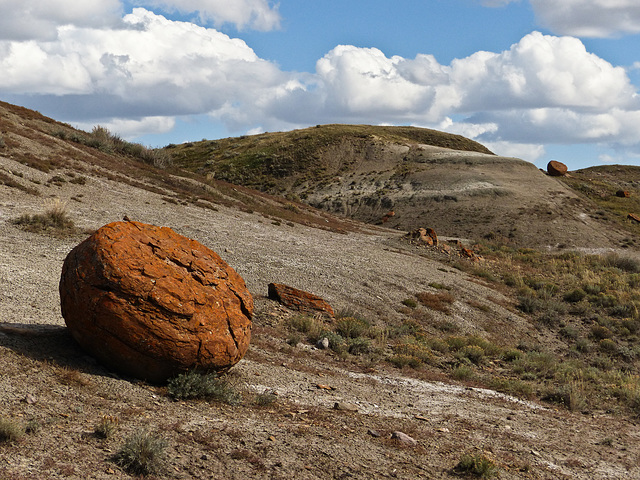cf Megaspora verrucosa lichen
Kinnikinnick / Bearberry sp.
Enjoying the sunshine
White Pigeon
Just for fun
Splendour
A bird walk treat
Ominous clouds after the harvest
Replica of a Chinese warrior
Seven-spotted Ladybug on Yucca seedpod
Strawberry and Rhubarb tart
Erosion at Red Rock Coulee
Yellow-rumped Warbler
Wall decoration
A joy to see
Coral Fungus sp
Common Sargeant / Athyma perius
Pink for Breast Cancer Awareness month
At least there were cows
Creeping Thistle
A touch of autumn colour
Fake but fun
Mt. Yamnuska, Kananaskis
Sharp-tailed Grouse
One of my favourite Lichens
Greeting the sun
Pronghorn
Lichens at Red Rock Coulee
Sunset over Elkwater Lake, SE Alberta
The final splurge
Ambush Bug / Phymata americana americana
Oh, what a treat!
Surprise visitor
Pinedrops / Pterospora andromedea
Bow Lake with a difference
Green stripes
Hungry litttle Muskrat
Bad hair day
Lower Falls, Johnston Canyon
Daintiness
Massive
White Camas / Anticlea elegans, formerly Zigadenus…
Beauty in stone
Little alien at Lake Louise
Silene sp
Location
See also...
Authorizations, license
-
Visible by: Everyone -
All rights reserved
-
305 visits
Uniqueness


Another landscape photo taken at Red Rock Coulee in SE Alberta. We left Calgary on Monday morning, 20 September 2013, and had to reach Elkwater in the Cypress Hills (not that far from the Saskatchewan border), several hours' drive away, where we were going to stay in a little rustic cabin for three nights. On the way there, we stopped at Red Rock Coulee, which is just 56 kms (35 mi) southwest of Medicine Hat. Actually, this particular photo was taken on Monday, 23 September 2013, when we called in again, this time walking down the hillside and into one of the coulees. While my friends searched for Lichens, I wandered around, taking photos of the scenery and anything else I came across. While we were down there, the sky had filled with some rather nice clouds, which I appreciated. However, the extremely high winds were not pleasant at all, to say the least! In fact, strong winds were everywhere in many parts of SE Alberta. I was expecting a lot of my photos to be blurry, as I could barely keep my balance or hold my camera. Amazingly, most seem to be OK, from the very quick look I've taken so far. This is Rattlesnake territory, too, but fortunately we didn't come across any, thank goodness! At least, not here, but one was seen (not by me!) at the Pinhorn Grazing Lease, when we were monitoring the Yucca plants.
"The main feature of this natural landscape is the huge red boulders; some measuring 2.5 m across. They are scattered over a relatively small distance. Bedrock is close to the surface in this area, covered by only a thin layer of soil. Water erosion has carved the landscape over time and a badlands topography has formed in places. The bands of colour visible in the exposed bedrock are made of dark gray shales, greenish and gray sandstones, bentonitic clays and thin bands of ironstone.
The most striking features of this landscape are the round reddish boulders. These are sandstone concretions and at up to 2.5 m in diameter, they are among the largest in the world. The boulders were formed in prehistoric seas as layers of sand, calcite and iron oxide collected around a nucleus formed by shells, leaves or bones. The concretions grew larger as the circulating waters deposited more layers. The reddish colour comes from iron oxide." From Wikipedia.
en.wikipedia.org/wiki/Red_Rock_Coulee
"The main feature of this natural landscape is the huge red boulders; some measuring 2.5 m across. They are scattered over a relatively small distance. Bedrock is close to the surface in this area, covered by only a thin layer of soil. Water erosion has carved the landscape over time and a badlands topography has formed in places. The bands of colour visible in the exposed bedrock are made of dark gray shales, greenish and gray sandstones, bentonitic clays and thin bands of ironstone.
The most striking features of this landscape are the round reddish boulders. These are sandstone concretions and at up to 2.5 m in diameter, they are among the largest in the world. The boulders were formed in prehistoric seas as layers of sand, calcite and iron oxide collected around a nucleus formed by shells, leaves or bones. The concretions grew larger as the circulating waters deposited more layers. The reddish colour comes from iron oxide." From Wikipedia.
en.wikipedia.org/wiki/Red_Rock_Coulee
, , novogorodec, LeapFrog have particularly liked this photo
- Keyboard shortcuts:
Jump to top
RSS feed- Latest comments - Subscribe to the comment feeds of this photo
- ipernity © 2007-2024
- Help & Contact
|
Club news
|
About ipernity
|
History |
ipernity Club & Prices |
Guide of good conduct
Donate | Group guidelines | Privacy policy | Terms of use | Statutes | In memoria -
Facebook
Twitter

Sign-in to write a comment.